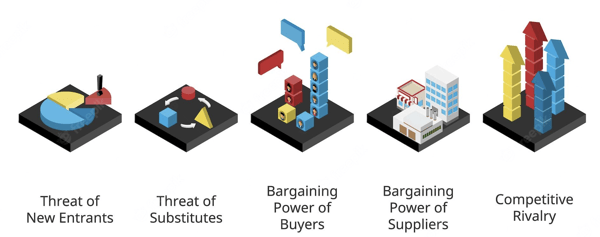The pace of change in industry forces means that companies must continually adapt their strategies to remain competitive. The key to success lies in anticipating shifts in the market and proactively developing a long-term plan for growth. To assist in developing a successful business strategy, there are five competitive forces to be aware of:
- Thread of New Entrants
- Threat of Substitutes
- Bargaining Power of Buyers
- Bargaining Power of Suppliers
- Competitive Rivalry
The framework behind business strategy
A business strategy is a roadmap for success, identifying what needs to be done, who will do it and when it needs to be done. At its core, it is a decision-making framework that will help you navigate the competitive landscape and achieve your company’s objectives. It is a tool that can be applied to any industry, sector or company and can be customized to meet the needs of your business. A business strategy is made up of three inter-related areas of business management - the industry analysis, the company analysis and the SWOT analysis. Industry analysis looks at the macro-environmental factors such as the regulatory environment, technological trends and demographic changes that impact your business. Company analysis examines the unique strengths, weaknesses, opportunities and threats that your company faces. SWOT stands for Strengths, Weaknesses, Opportunities and Threats. It is a tool used to evaluate the external factors impacting your business strategy.
The benefits of an effective business strategy
An effective business strategy allows you to take full advantage of your company’s strengths and minimize threats that could otherwise derail your business. It is important to evolve your strategy as the market changes. Business strategy is important because it helps you to:
1. Understand your business’s strengths and weaknesses
2. Nail down your position in the competitive landscape
3. Identify opportunities to grow your business
4. Develop a plan based on qualitative and quantitative insights to capitalize on opportunities
Five competitive forces that shape your business strategy
1. Threat of new entrants
It is imperative to understand the powerful forces at work that can shape your market and overall business strategy. The first is a threat of new entrants. With heavy venture capital funding in certain markets and the pace of innovation, product uniqueness and competitive moats are getting disrupted. Take a look at your product and assess whether your market could be disrupted by a new competitor with a similar product but has some other differentiation (price, speed, ease of use, etc.) If your product is highly unique and has an intellectual property differentiator that protects it from replication, this is less of a concern for you.
2. Threat of substitutes
It is common for competitors to launch modules or features that bring them closer to your competitive sphere. The key here is to look at vendors in the market that have similar customer personas to you. They may not compete directly today but could launch a substitute in your vertical and steal market share rapidly.
3. Bargaining power of buyers
In a hypercompetitive market with direct competitors, buyers have alternatives. What tends to happen in these markets is a race to zero. When the buyers know that there are close alternatives, they tend to negotiate more heavily which can impact your entire market space.
4. Bargaining power of suppliers
The recent supply chain woes have been a major driver of inflation. Suppliers with in-demand products can charge a nearly unlimited amount if the demand is high enough, and your organization has to purchase those products if there are no other suppliers to purchase an equivalent product from. This in turn can eat into your profit margins or result in a need to increase your prices to the consumer.
5. Competitive rivalry
And the final competitive force that may affect your business strategy is competitive rivalry. This is normally seen in two types of markets. Emerging markets where there are two heavily funded startups fighting for market share, or longstanding markets where there is a duopoly. If you are able to identify key competitive differentiators in this type of market you can gobble up your competitors' lunch. This is an area where business strategy is so key because the competitive risk is particularly high.
Conclusion
A business strategy is a long-term decision-making framework that allows companies to navigate the competitive landscape and achieve objectives. It is made up of three interrelated areas of business management; the industry analysis, the company analysis and the SWOT analysis. With a strong business strategy, your stakeholders will have the tool to understand their landscape, align all internal staff on the company's objectives, and ensure that you have a fighting chance to win in your market.
Ready to level up your competitive strategy? Explore 6 ways to map your competitive landscape with our competitive analysis matrix, or download our free ultimate guide to competitive analysis.


COMMENTS